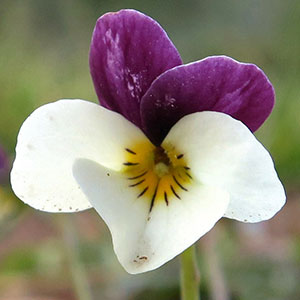Viola hallii
Viola missouriensis
Hall's violet, Oregon violet, wild pansy
Missouri violet
1–3, decumbent or ascending to erect, ca. 1/2 subterranean, glabrous, clustered on single, short, vertical, deep-seated caudex.
basal and cauline;
basal: 1–4, palmately compound, ± 2-ternate or 3-ternate, leaflets 3;
stipules adnate to petiole, forming 2 linear-lanceolate wings, unlobed, margins entire, apex of each wing free, acute;
petiole 5–8 cm, glabrous;
blade ovate to deltate, 2.8–6 × 2.6–6.5 cm, ± coriaceous, base tapered, ultimate lobes narrowly elliptic, lanceolate, or oblanceolate, 1–7 mm wide, margins entire, ciliate or eciliate, apex acute, mucronulate, surfaces glabrous;
cauline similar to basal except: stipules usually lanceolate, sometimes broadly ovate, ± leaflike, margins toothed;
petiole 1.3–6 cm;
blade 2–4.8 × 1.2–5.5 cm.
basal, 1–8, ascending to erect;
stipules linear-lanceolate to broadly lanceolate, margins entire, sometimes distally glandular, apex acute;
petiole 5–20 cm, glabrous;
blade green abaxially, unlobed, usually narrowly to broadly deltate, 1.5–12 × 1.5–10 cm, not fleshy, base cordate or broadly cordate to truncate, margins ± crenate to serrate, ciliate or eciliate, apex acute to acuminate, surfaces glabrous, rarely pubescent.
2.5–11 cm, glabrous.
3–25 cm, usually glabrous.
sepals lanceolate to ovate, margins ciliate, auricles 0.5–1 mm;
petals: upper 2 almost black abaxially, dark reddish violet adaxially, lower 3 pale yellow, cream, or ± white, lateral 2 bearded, with deep yellow to orange patch basally, dark reddish violet-veined, lowest with deep yellow to orange patch basally, dark reddish violet-veined, 5–18 mm, spur yellow, gibbous, 0.5–2 mm;
style head bearded; cleistogamous flowers absent.
sepals lanceolate to ovate, margins ciliate or eciliate, auricles 1–2 mm;
petals light to dark blue-violet, lowest and sometimes lateral 2 purple-veined, lateral 2 bearded, lowest beardless, rarely lightly bearded, 15–25 mm, spur same color as petals, gibbous, 2–3 mm;
style head beardless; cleistogamous flowers on prostrate to ascending peduncles.
ellipsoid, 4–12 mm, glabrous.
ellipsoid, 5–12 mm, glabrous.
light brown, shiny, 3.2–3.5 mm.
beige, mottled to bronze, 1.5–2.5 mm.
= 60, 72.
= 54.
Viola hallii
Viola missouriensis
Viola hallii was discovered on the grounds of Willamette University in Salem, Oregon, by Elihu Hall, a professor at that institution (V. B. Baird 1942). Leaves of V. hallii are similar to V. beckwithii.
(Discussion copyrighted by Flora of North America; reprinted with permission.)
What many have treated as Viola affinis, especially in the southern Gulf coastal states, is likely to be V. missouriensis. N. H. Russell (1965) considered the two as likely part of a species complex inhabiting alluvial woods and wet areas and exhibiting the typical deltate leaf blade shape. L. E. McKinney (1992) considered V. missouriensis a variety of V. sororia. Viola missouriensis appears to have a closer affinity to V. affinis, as Russell suggested; current evidence suggests maintaining V. missouriensis as a separate species.
(Discussion copyrighted by Flora of North America; reprinted with permission.)


